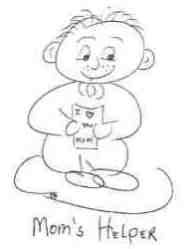The story you’re about to read is true. I warn you, however, that I make up some of my true stories and you’ll have to decide for yourself.
For many years, I taught Industrial Arts Metalworking. During the course of instruction, as technical processes and tools were introduced to the class, students would ask questions as to their origin and development. Finally, after listening to the same questions over and over again and, sensing a need to liven up drab, technical information with a little humor, I began fabricating creative responses to student questions. One such inquiry dealt with the source of steel wool: “Mr. Koch, where does steel wool come from?” It was time to tell the “…rest of the story.”
Once upon a time, many years ago, there was a special breed of sheep that lived in North Dakota. These hybrid sheep were raised for their unique type of wool. Genetically, because of a unique endocrine and metabolic system, their follicles had extremely high iron content enabling these sheep to produced steel wool. Because of their metallic hair, and subsequent heavy body weight, these sheep needed exceptional care and tending.
Ranchers involved in raising these animals were licensed under Federal Agriculture Law—#0000-000-00-0-1-2-3-4. They were mandated, by sworn oath, to protect the health and well being of these sheep from life-threatening hazards and injuries. In short, ovine managers pledged to keep these sheep out of the rain. Should these iron-saturated mutton munchers get wet—they would—in a short period of time, corrode out of existence.
Unfortunately, fate was not kind to these sheep. During the annual Steel Wool Growers Association (SWGA), meeting in Indianapolis, a time when watchful steel wool ranchers were away from their flocks and out of town, the unexpected happened. Severe thunderstorms deluged the North Dakota pastures where these sheep grazed.
Sadly, the majority of the steel wool-bearing sheep had been left out on the open range unprotected from the elements. As sheep after sheep became soaked by heavy rain, thousands of them succumbed to iron oxide corrosive syndrome. Aerial photographs, taken after the severe weather showed pathetic, reddish-brown blotches against the landscape’s green meadows: stark physical evidence of the now-terminally rusted herds.
These storms had a devastating corrosive effect on the steel wool industry. It was nearly rusted out! But as bad as things appeared, all was not lost. Luckily, several breeding pairs of steel wool sheep had survived. Fearing possible extinction, the Federal Government immediately placed these animals on its endangered species list and banned all scouring: then took deliberate measures to restore this vitally important breed of livestock.
Follow-up studies by the U. S. Department of Agriculture revealed the surviving sheep suffered from deep depression. (Under the circumstances, it was quite understandable) The symptoms included cloudy eyes, listlessness, and (forgive me), sheepishness. Even though massive doses of a high potency iron tonic were administered, the depression was so immobilizing surviving sheep didn’t even have enough strength to point North. Ranchers were being fleeced.
As last resort, sheep specialists from the United States and Mexico recommended a geographical change. They proposed rebuilding the herd by relocating them to a dry, rain-free environment. By moving the herd, veterinary-scientists hoped the sheep would overcome their mutton malaise, thrive, and produce enough steel wool to relieve a growing worldwide shortage. After scouring the map, such a location was found on the Northwestern peninsula of Mexico just south of the U.S. border.
Not only did the herd thrive and propagate; and, not only was the steel wool industry saved from economic ruin, but the sheep overcame their depression.
Once the sheep had rid themselves of the “mutton Malaise,” they became happy animals. The more time sheep spent in the hot, rain-free, dry climate of their new west coast homeland, the happier they became. Soon they were laughing: BA-HA, BA-HA, BA-HA. Hundreds of thousands of happy laughing sheep could be heard all across the land: BA-HA, BA-HA, BA-HA.
The nearby residents looked upon these gleeful sheep as a good luck sign. Somehow the citizens knew that better times were just around the corner. To recognize their impending good fortune, Hispanic city officials, decided to name the land after the laughing sheep. And so they did. That was a long time ago.
Even so, to this day, this land is still known by the name it was given because of the laughing sheep. I know you’ve heard of this place. It’s called: “Ba-Ja” California!
Subscribe to:
Post Comments (Atom)
Where's Al going to be next???
Check back soon for his next appearance at a location near you!


No comments:
Post a Comment